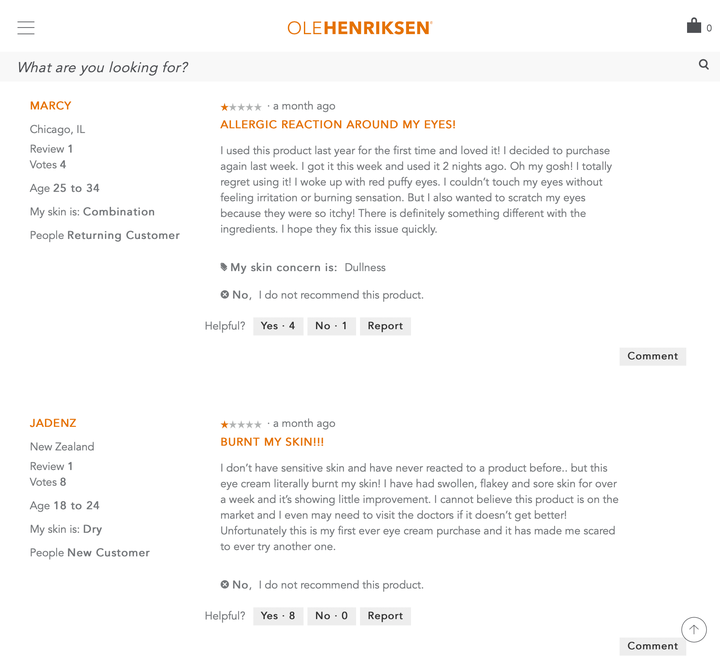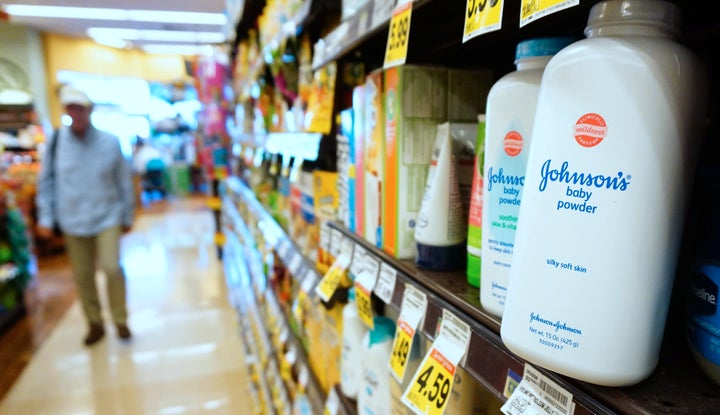The 2019 documentary “Toxic Beauty” opens with a striking quote: “The cosmetics industry is destroying women’s cells.” C-E-L-L-S, the interviewee spells out in case there was any doubt that yes, she’s talking about our literal cells.
The film unpacks the harmful ingredients inside beauty products while following a class-action lawsuit against Johnson & Johnson in which hundreds of women contend that use of the brand’s baby powder led to their cancer.
Talc, the main ingredient in baby powder, may contain naturally occurring asbestos, which is itself a known carcinogen. But despite studies that suggest asbestos-contaminated talc can be dangerous, it is not explicitly banned by the Food and Drug Administration. Meanwhile, talc is found in a wide range of cosmetic products including lipsticks, face powders, foundations, deodorants, eyeshadows and face masks.
And talc isn’t the only risky ingredient out there.
Compared to the European Union’s list of more than 1,000 banned cosmetic ingredients, the FDA has only banned 11. It’s no wonder consumers have been turning to “clean beauty” products.
“Clean beauty,” though it’s a tens-of-billions-of-dollars industry and growing, lacks an official definition. For some, it means “organic.” For others, it means “natural” ingredients. It might mean environmentally friendly and cruelty-free development and production. Mostly, it’s supposed to be safe.
But the lack of knowledge and oversight means that it’s not enough to rely on a company’s own claims of safety. Just because a bottle reads “100% Natural!” or “paraben-free” doesn’t mean you should trust the product.
“There is no data showing that clean skin care products are any more effective or even any safer than traditional products. In fact, there are many botanical ingredients that have been shown to cause skin allergies or irritation,” said Joshua Zeichner, a New York City-based dermatologist. “Natural ingredients commonly found in clean skin care products that have been associated with contact dermatitis include aloe, cucumber, ginkgo, lavender oil, peppermint, rosemary, chamomile, and tea tree oil,” he noted.
“I’ve seen a number of patients who have had allergic contact dermatitis caused by essential oils,” said Hadley King, also a dermatologist in New York.
She also noted, “Toxic heavy metals like aluminum, cadmium, lead, mercury and arsenic sometimes end up in cosmetics, particularly mineral makeups.”
Although a single product probably doesn’t contain enough of these ingredients to cause harm, a buildup of heavy metals can cause gastrointestinal distress and damage organs, among other problems. They are especially harmful to babies and young children.
Rex Chou, founder of the beauty brand Ghost Democracy and previously employed in product development at L’Oreal, warned that products with fragrance can hide more sinister ingredients. “Not only can fragrance be sensitizing to skin, this is a very misleading ingredient. Almost all skin care products contain added fragrance, and since brands don’t have to reveal what’s in them, they can often be contaminated with carcinogens, endocrine disruptors, petrochemical and phthalate derivatives,” he said.
Ole Henriksen Banana Bright Eye Creme, which is marked “clean” at Sephora, is an example of how that one word doesn’t necessarily mean you personally will have no problems with a product. A scroll through the reviews reveals, amid the glowing praise, a long list of people who say they developed severe reactions after using the eye cream for several months. While Zeichner said each individual’s reaction and its cause may be different, he pointed to non-paraben preservatives, botanical extracts — especially from citrus fruits — and even vitamin C as possible skin irritants.

Sulfates still linger on some clean beauty ingredient lists, too. While generally safe for use, sodium lauryl sulfate (SLS) can be harsh — it causes me to break out — and it can exacerbate eczema. Lush, known for its bath bombs, is often thought of as a clean brand but it still puts the ingredient in many products because of the rich foam it creates. (Lush’s website includes a page on every ingredient, and this one explains why the brand continues to use SLS.)
The overarching problem for consumers is that we don’t always know what’s in our beauty products and what the potential implications are. In some cases, ingredients are not noted on the label (like what “fragrance” consists of) or come with hidden contaminants (like asbestos in talc). In most cases, even if we know what’s there, there’s just not enough data to understand how it will affect us.
And even where studies have been done, they aren’t always comprehensive enough to draw any real conclusions. Sometimes what we think we’ve learned has been debunked. For instance, after some studies suggested that lavender and tea tree oil could cause breast growth in young boys, more recent studies show no link.
Michelle Wong, who has a Ph.D. in chemistry and runs the Instagram account @labmuffinbeautyscience, is a clean beauty skeptic. “The problem is that every ingredient has a safe level, and every ingredient is harmful when used in excess, so there aren’t really any brands that have a scientifically accurate definition of ‘clean,’” she said.
But she agrees that we still need to learn more, depending on the specific ingredient and the likelihood of harm. “In general, more research is always good. This is especially the case when ingredients that have a known small risk of harm and a long history of safe use, like parabens, are being replaced by ingredients with very little data on them,” she said, adding that just because we don’t have much data on an ingredient doesn’t mean it’s unsafe.
And we shouldn’t talk about clean beauty products without acknowledging that for many companies, the label is simply a business opportunity.
“A lot of companies are just being opportunistic and jumping on the ‘clean beauty’ bandwagon, and simply by not using sulfates or parabens they are self-proclaiming themselves a clean brand,” Chou said.
He warned, for example, that even clean beauty products may contain filler ingredients or plasticizers that are linked to endocrine disruptors or carcinogens, such as hydroquinone and butoxyethanol.

Change is at least on the congressional table with the proposed Cosmetics Safety Enhancement Act. It’s been more than 80 years since even a House committee has voted to make health and safety reforms in the cosmetic industry (previous debates went without a vote). This bill, if passed, would require companies to test the safety of their products and notify the FDA of any health concerns.
Phyllis Ellis, the director of “Toxic Beauty,” is optimistic about what the bill might do. “It’s the only federal cosmetic safety legislation that would immediately ban more than 12 of the worst toxic chemicals from cosmetics, fund research for safer alternatives and require full fragrance ingredient exposure, which is vital,” she said.
Until then — and even after — it’s up to consumers to tread carefully. The best way to judge beauty products is to read the label and examine the known data. While online resources can be helpful, think about their pros and cons too.
King said that the approach of the Environmental Working Group’s Skin Deep site, for example, seems to be “better safe than sorry.” She argued that can sometimes “lead to misplaced fear.”
“What is more important than choosing a product that is labeled as ‘clean’ is to choose a product that is free of ingredients that are a potential source of skin allergies or irritation,” Zeichner suggested.
Just remember that when a brand says its products are clean, that doesn’t automatically mean those products are safe. Until companies are held to a higher standard by law, it’s up to us as consumers to scrutinize the beauty products we use.